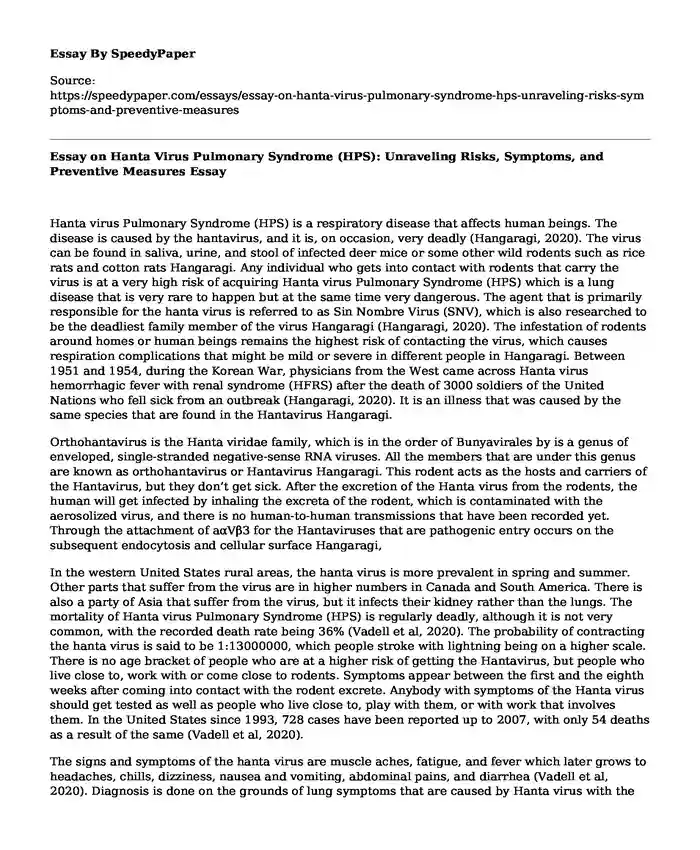
| Type of paper: | Essay |
| Categories: | Health and Social Care |
| Pages: | 3 |
| Wordcount: | 706 words |
Hanta virus Pulmonary Syndrome (HPS) is a respiratory disease that affects human beings. The disease is caused by the hantavirus, and it is, on occasion, very deadly (Hangaragi, 2020). The virus can be found in saliva, urine, and stool of infected deer mice or some other wild rodents such as rice rats and cotton rats Hangaragi. Any individual who gets into contact with rodents that carry the virus is at a very high risk of acquiring Hanta virus Pulmonary Syndrome (HPS) which is a lung disease that is very rare to happen but at the same time very dangerous. The agent that is primarily responsible for the hanta virus is referred to as Sin Nombre Virus (SNV), which is also researched to be the deadliest family member of the virus Hangaragi (Hangaragi, 2020). The infestation of rodents around homes or human beings remains the highest risk of contacting the virus, which causes respiration complications that might be mild or severe in different people in Hangaragi. Between 1951 and 1954, during the Korean War, physicians from the West came across Hanta virus hemorrhagic fever with renal syndrome (HFRS) after the death of 3000 soldiers of the United Nations who fell sick from an outbreak (Hangaragi, 2020). It is an illness that was caused by the same species that are found in the Hantavirus Hangaragi.
Orthohantavirus is the Hanta viridae family, which is in the order of Bunyavirales by is a genus of enveloped, single-stranded negative-sense RNA viruses. All the members that are under this genus are known as orthohantavirus or Hantavirus Hangaragi. This rodent acts as the hosts and carriers of the Hantavirus, but they don’t get sick. After the excretion of the Hanta virus from the rodents, the human will get infected by inhaling the excreta of the rodent, which is contaminated with the aerosolized virus, and there is no human-to-human transmissions that have been recorded yet. Through the attachment of aαVβ3 for the Hantaviruses that are pathogenic entry occurs on the subsequent endocytosis and cellular surface Hangaragi,
In the western United States rural areas, the hanta virus is more prevalent in spring and summer. Other parts that suffer from the virus are in higher numbers in Canada and South America. There is also a party of Asia that suffer from the virus, but it infects their kidney rather than the lungs. The mortality of Hanta virus Pulmonary Syndrome (HPS) is regularly deadly, although it is not very common, with the recorded death rate being 36% (Vadell et al, 2020). The probability of contracting the hanta virus is said to be 1:13000000, which people stroke with lightning being on a higher scale. There is no age bracket of people who are at a higher risk of getting the Hantavirus, but people who live close to, work with or come close to rodents. Symptoms appear between the first and the eighth weeks after coming into contact with the rodent excrete. Anybody with symptoms of the Hanta virus should get tested as well as people who live close to, play with them, or with work that involves them. In the United States since 1993, 728 cases have been reported up to 2007, with only 54 deaths as a result of the same (Vadell et al, 2020).
The signs and symptoms of the hanta virus are muscle aches, fatigue, and fever which later grows to headaches, chills, dizziness, nausea and vomiting, abdominal pains, and diarrhea (Vadell et al, 2020). Diagnosis is done on the grounds of lung symptoms that are caused by Hanta virus with the help of x-rays with specialized lab results giving the final and actual diagnosis. There is still no vaccine for the virus, and early intensive care helps in recovery, which might take three to six weeks (Vadell et al, 2020). The survivors of the virus might have shortness of breath, fatigue, and myalgias five years later. The hanta virus can be prevented by rodent infestation prevention, disinfecting all contaminated areas, and proper cleaning (Carbajo, 2020).
References
Hangaragi, P. S. (2020). Hantavirus: An emerging global threat. Asian Journal of Oral Health and Allied Sciences, 10. https://ajohas.com/hantavirus-an-emerging-global-threat/
Vadell, M. V., Villafañe, I. E. G., & Carbajo, A. E. (2020). Hanta virusinfection and biodiversity in the Americas. Oecologia, 192(1), 169-177. https://link.springer.com/article/10.1007/s00442-019-04564-0
Cite this page
Essay on Hanta Virus Pulmonary Syndrome (HPS): Unraveling Risks, Symptoms, and Preventive Measures. (2023, Nov 12). Retrieved from https://speedypaper.com/essays/essay-on-hanta-virus-pulmonary-syndrome-hps-unraveling-risks-symptoms-and-preventive-measures
Request Removal
If you are the original author of this essay and no longer wish to have it published on the SpeedyPaper website, please click below to request its removal:
- Essay Example Discussing Access to Healthy Foods in Urban Communities
- Free Essay Example. the Homeless and Health Promotion
- Using Humans for Research. Paper Sample
- Auditing in Healthcare Organizations: Essay Sample on Financial Performance and Assurance
- Free Essay Sample on Theory Practice
- Nurse Advocacy: Shaping Healthcare Policies for Community Well-being - Essay Sample
- Navigating California's Abortion Laws: Controversies, Ethical Considerations, and Social Work Perspectives
Popular categories




